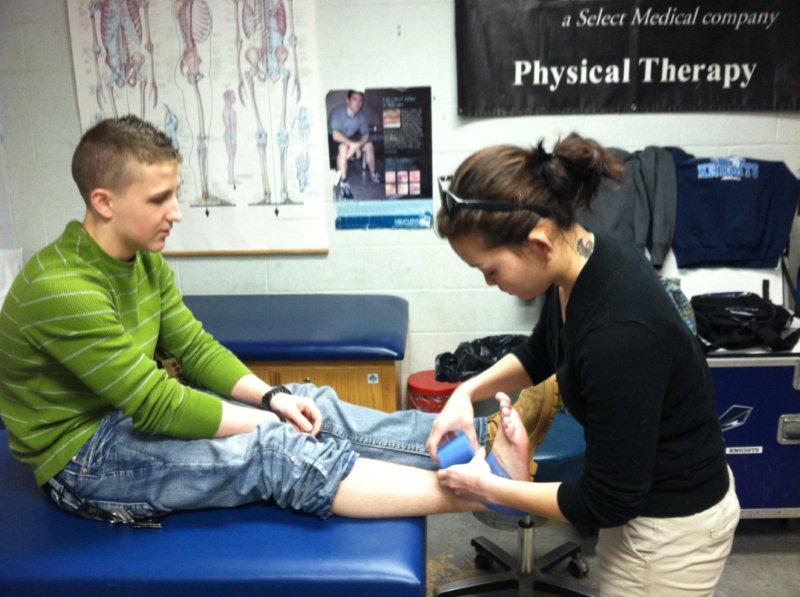TOWAMENCIN- Tape, ice, wrap, heat, cold, gauze, exercise bands… it can all be found behind one important set of wooden doors in the H-pod hallway at North Penn High School. While the spotlight often shines on the athletic fields, it is the happenings of that training room that make it possible for the success on the field. And just in time for spring sports to begin, across the country March is recognized as Athletic Training Month.
National Athletic Training Month is a time to spread the word about the profession of athletic training as well as to appreciate all they do for people all around the world. Unlike many other events, Athletic Training Month is not highly publicized or appreciated by the masses. The goal of the recognition is to spread the word about the magnitude of Athletic Training as well as inform people about how important the line of work is. This year’s theme of the month is “Athletic Trainers save lives.”
“It’s an opportune time for us in the profession to educate others on what we do and the value of the services we provide for athletes of all ages, “said NPHS athletic trainer, Leanne Edwards. “The younger athletes are a more at risk group and they are underserved; a lot of times they are relying on family physicians, pediatricians and their parents to help them through their injuries, and with our experience level sometimes we can narrow that down and help guide them to the proper physician. If not us that can help address their situation.”
Athletic trainers are health care professionals who work in a variety of settings and with all kinds of people, not just athletes. Athletic trainers are on-site workling with patients to avoid injuries; they’re there when injuries happen and they provide immediate care while rehabilitating patients after injuries or surgery. Athletic trainers treat a broad population, from the amateur and professional athlete to the typical patient in need of rehabilitative care. The National Athletic Trainers Association describes typical clients groups as “recreational, amateur and professional athletes, individuals who have suffered musculoskeletal injuries, those seeking strength, conditioning, fitness and performance enhancement, and others designated by the physician.”
“I like working in this setting,” said student athletic trainer Kelsey Lepore. “Its fun working with athletes and helping them to be able to do what they love, I especially like how it’s never going to get boring, and you never know what’s going to walk through those wooden doors. North Penn has been a very exciting place to learn about athletic training; there are a variety of sports and athletes to get to know and work with, as well as the privilege of learning from Abott and Edwards.”
Here at North Penn we have had many athletic trainers that we would like to take time to appreciate, specifically our current athletic trainers, Beth Abbott and Leanne Edwards.
“For me it’s a time where athletic trainers can really be proud of our profession, many times it’s overlooked so it’s great to have a month to bring awareness to what we do and how important our jobs are. As athletic trainers we have medical training whereas coaches or a nurse may not know what to do necessarily in a sports related emergency situation. So it is important as well as convenient for us to be there so the athletes can get the care they need,” said Abbott.
“The value of an athletic trainer is to help keep an athlete on the field as long as possible, to know the difference between when an athlete is really injured and should not be participating and when it is okay to allow that participation so the potential for time lost can be minimized,” added Edwards. “We also don’t charge for our services in terms of stem, ultrasound, ice, heat, things of that nature, whereas a doctor or a physical therapist will charge you for that , so the school gets that in lump sum so we can provide these services, the evaluations, as well as the rehabilitation.”
At North Penn High School, the training room can be a particulalry bustling place as dozens of athletes will often descend upon the room before and after practice and games. The position requires many attributes beyond just book and medical knowledge.
“In order to be successful in this environment you have to be organized, able to manage your time, you have to get kids to be able to trust you as well as having an open channel of communication with coaches, adults, parents, aids – pretty much everyone. I went to school at Pitt working with gymnastics, wrestling and football during my studies there. This is my first job out of practice so here you get a lot of different things. I want to bring to light the importance of an athletic trainer,” said Abott.
“I became an athletic trainer because I like being able to help people, if we can help asses an injury or illness faster or if it cuts down the time out, that’s rewarding to me. The athletes make me smile at work, the things they say and do are amusing and it’s genuine, I appreciate all of those relationships,” reflected Edwards.
Below is a link to a white house petition that was started in an attempt to get athletic trainers involved with all youth sports. If the president gets 100,000 seconds to this motion online he will review it, so it is highly appreciated if people can take a few minutes and sign the motion because it is very import in this day and age for there to be an athletic trainer involved in youth sports to prevent injuries from an early age.


